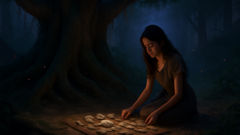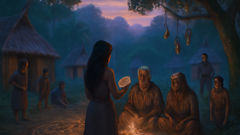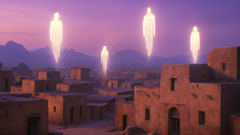Introduction
In the heart of the South Pacific, where the sapphire sea kisses emerald coasts, lie the Solomon Islands—a sprawling archipelago shrouded in ancient mystery. These islands, clothed in dense jungle and punctuated by rugged volcanic peaks, have long whispered secrets to those who listen. The forest canopy is so thick in places that sunlight becomes a rare treasure, filtering through layers of leaves in shifting mosaics of green and gold. Between towering banyans and twisted mangroves, the land is alive with sound: the distant thrum of cicadas, the calls of kingfishers, and the gentle sigh of a breeze heavy with the scent of damp earth and wild orchids. But beneath the beauty lies another world, one unseen by most—a realm where legend and reality blend. Here, within shadowy caves and tangled undergrowth, dwell the Kakamora: tiny, hairy, and elusive spirits older than memory itself. Islanders tell stories of these mysterious beings, describing their mischievous pranks and their fierce guardianship of nature’s order. To the uninitiated, the Kakamora might seem mere tales, a trick of the mind, or perhaps warnings for wayward children. But those who walk the jungle paths with respect—and a touch of caution—know better. The Kakamora are real, and their presence is felt in every rustle, every echo, every unexpected gust that sets the palms swaying. To disrespect the forest is to invite their wrath; to honor it is to share in its blessings. This is the story of Marita, a young woman from a coastal village, whose restless curiosity draws her into the heart of the jungle, where the secrets of the Kakamora wait to be revealed. Her journey, at once magical and perilous, will reshape her understanding of her people, her land, and herself.
Into the Heart of the Jungle
Marita had always been drawn to the forest’s edge, lingering beneath the ancient breadfruit trees that separated her village from the wild unknown. The elders often warned children not to wander too far, spinning tales of the Kakamora—spirits with wild hair and sharp eyes who hid in the gloom, always watching. Some said they were protectors, others swore they could be spiteful if angered. Marita listened, fascinated, but she wasn’t afraid. The jungle, to her, was a living tapestry: tangled vines heavy with passionfruit, birds flashing like jewels between leaves, and secret paths that beckoned to those with brave hearts. One humid morning, curiosity overcame caution. Marita set out alone, following a winding game trail deeper than she’d ever dared to go. Her basket was light, packed with roasted taro and a single carved shell for luck. The forest seemed to welcome her at first. Sunlight shimmered across dewdrops, and butterflies danced around her feet. She walked for hours, deeper into shadows, past trees older than her ancestors, until even the familiar birdsong faded into a hush. That’s when she saw it: a small, crudely woven mat near the base of a giant fig tree, adorned with shiny shells and bird feathers. Marita knelt beside it, fingers trembling. This was no ordinary place. It was a Kakamora offering site—a warning and a welcome, all at once. As she looked up, the air changed. Shadows twisted and lengthened, and the jungle’s silence grew thick, like a breath held in anticipation. Marita knew she had crossed a threshold. She pressed her shell charm to her lips and whispered a prayer, remembering her grandmother’s words: “Respect the forest and its spirits will guide you; dishonor it and they will never let you leave.”

Her journey continued beneath an ever-darkening canopy. Strange, flickering lights danced just beyond her vision, and sometimes she thought she heard giggles or the crack of twigs—too light for any animal she knew. Once, she glimpsed a pair of glinting eyes between the roots of a banyan. She froze, heart pounding, but when she looked again they were gone. She pressed on, wary yet awed by the living presence around her. As night descended, Marita stumbled upon a cave entrance draped with lianas and veiled in mist. A faint, sweet scent—half honey, half earth—wafted from within. She hesitated, torn between fear and fascination, then ducked inside, her steps echoing against the stone.
The cave’s interior shimmered with phosphorescent moss, casting an eerie green light. The walls were etched with ancient markings: spirals, handprints, and curious figures dancing in circles. Marita followed the carvings deeper, until she entered a hollow chamber unlike anything she’d seen. There, standing just at the edge of the glow, was a Kakamora. He was no taller than her knee, his hair wild as dried sea grass, his eyes bright with mischief and intelligence. Around him, other shapes gathered—small silhouettes with curious faces. They watched her, silent as shadows, but not unfriendly. Marita bowed her head, recalling her grandmother’s stories. She spoke softly, offering her shell as a token of respect. The Kakamora chattered among themselves, then the leader stepped forward and pressed a tiny, three-fingered hand to her palm. A warmth spread through her body—a welcome, and a challenge. She had entered their realm, and nothing would ever be the same.
The Realm of the Kakamora
Marita’s breath caught as the warmth from the Kakamora’s touch spread through her limbs. The chamber around her seemed to pulse in response—walls flickering with bioluminescent moss, shadows dancing in silent approval. The Kakamora leader, whose name she’d later learn was Tana, beckoned her to follow. The other spirits fell in behind, their tiny feet making only the barest whisper on the stone. Marita moved deeper into the caves, guided by the ever-present glow and the gentle hum of ancient songs that seemed to vibrate through the rock. Tana moved with the confidence of one who belonged to the very bones of the island. He led Marita through winding tunnels painted with murals: scenes of volcanic eruptions, great migrations across the sea, and—most often—images of Kakamora tending to forests, mending broken branches, and chasing away hunters who took more than their share. Here, the Kakamora were not simply mischievous; they were caretakers, entrusted with the balance of life.

As they emerged into a hidden grotto, Marita gasped. The cave ceiling opened to a pocket of twilight sky, where vines hung in trailing curtains and a crystalline pool shimmered below. Dozens of Kakamora gathered here, their laughter echoing in the cool air as they played games with beetles and wove intricate patterns from grass and bark. A feast was underway: fruits stacked in bright pyramids, honeycombs dripping golden nectar, roasted yams steaming on banana leaves. Tana offered Marita a seat beside him and handed her a small bowl carved from coconut shell. The food was sweet and earthy—unlike anything she’d tasted—and as she ate, she felt her senses sharpen. She could hear the heartbeat of the land above, feel the pulse of roots beneath her feet. The Kakamora watched her closely, whispering among themselves in a language like wind through bamboo. Tana finally spoke, his voice a gentle murmur in Marita’s mind: “The jungle knows you. It listens to your heart. Will you listen to it?”
Marita nodded, unsure if she was awake or dreaming. Tana gestured, and suddenly Marita saw visions—the jungle’s memory unspooling before her eyes. She watched as settlers arrived on canoes, welcomed by Kakamora who taught them how to live in harmony with the land. She saw times of darkness, when outsiders felled trees without heed, and spirits wept as their home was scarred. She saw how every careless act echoed through the generations. Tears blurred Marita’s vision. She understood now: the Kakamora were guardians, their mischief a lesson, their anger a warning. To disrespect nature was to endanger all life.
As the night deepened, Marita was invited to join the Kakamora in their rituals. She learned their songs—melodies that mimicked birds at dawn and rain on leaves. She watched their dances, each step a prayer to keep balance. At dawn, Tana led her to a ledge overlooking the forest. Below, the jungle unfurled in all its glory—green hills rolling into blue mist, waterfalls tumbling like ribbons of silver. “You are one of us now,” Tana said softly. “You carry our story. Remember it, and protect it.” Marita’s heart swelled with pride and awe. She understood her purpose: to bridge the world of spirits and people, to carry the lessons of the Kakamora back to her own village and beyond.
Return and Reckoning
Emerging from the cave at dawn, Marita felt changed—her senses attuned to every breath of wind and the hidden stories in each rustle of leaf. She followed Tana’s silent directions through the waking jungle, every step guided by new understanding. The path home seemed shorter, or perhaps Marita moved with greater purpose now. As she neared her village, she noticed subtle signs left by the Kakamora: twined grass charms, small footprints pressed in soft mud, feathers arranged in mysterious patterns. These were reminders—both warnings and blessings—to those who respected or defied nature’s laws. The village was just stirring when Marita arrived. The elders sat in a circle by the fire, shell necklaces gleaming in the pale light. Her mother rushed to embrace her, tears streaming down her face. News of Marita’s disappearance had rippled through the community like a storm. Some feared she’d been taken by angry spirits. Others whispered that she’d gone willingly to seek forbidden knowledge.

Marita knelt before the elders, her shell charm clutched tightly in her hand. She told them everything—her journey through the jungle, her encounter with the Kakamora, and the visions she’d seen. At first, the elders listened in wary silence. But as Marita recounted the Kakamora’s teachings—the importance of balance, the need to honor the land—a shift rippled through the crowd. The old stories were true, Marita insisted, and the spirits’ warnings must be heeded. She shared the rituals she’d learned: offerings to leave at sacred sites, songs to sing at planting and harvest. She showed them the shell charm, now etched with new symbols—the Kakamora’s mark of trust.
Skepticism lingered among some villagers. But when they visited the forest, they found signs impossible to ignore: plants blooming out of season near old offering mats; animals returning to abandoned clearings; strange patterns appearing overnight in river stones. The jungle seemed to respond to Marita’s presence, as if vouching for her words. Over time, Marita became a bridge between worlds. She taught children how to read the forest’s signs and led ceremonies that honored both ancestors and spirits. Hunters learned restraint; gatherers took only what was needed, returning gifts to the earth. And when outsiders came, Marita stood firm—explaining the legends, defending sacred groves from careless destruction.
But not all encounters were peaceful. One season, a group of loggers arrived, seeking mahogany for foreign markets. They ignored the villagers’ warnings and hacked at ancient trees, their machines snarling like angry beasts. The jungle reacted swiftly: tools vanished in the night, paths became tangled with vines, and eerie laughter echoed through camp. When a logger fell ill with fever and raved about tiny figures watching from the shadows, the crew finally fled, leaving the forest in uneasy silence. Marita led a ritual of reconciliation at the scarred grove, asking forgiveness from the Kakamora and promising renewed vigilance. Slowly, the land healed, and balance was restored.
Years passed. Marita grew into a respected leader, her wisdom sought by neighboring islands. The legend of her journey—and her friendship with the Kakamora—spread far and wide. Some doubted, some believed, but all who ventured into the jungle learned to tread with care. The Kakamora remained elusive, glimpsed only by those whose hearts were true. Yet their presence shaped every life, every harvest, every breath of wind that stirred the leaves. Marita often returned to the cave at twilight, leaving gifts of fruit and song. In the soft glow of fireflies, she would sometimes catch a flicker of movement—a reminder that the guardians watched, forever entwined with the spirit of the land.
Conclusion
The story of Marita and the Kakamora endures wherever island breezes stir the leaves and ancient songs echo across moonlit water. Her journey reminds all who hear it that true harmony with nature requires more than fear or superstition—it demands humility, curiosity, and deep respect for the unseen world. The Kakamora remain guardians of the Solomon Islands, their laughter ringing in hidden grottos and their warnings carried on the wind. They are neither wholly kind nor cruel; their mischief is a mirror for those who would take without giving back. For every fruit plucked, every branch broken, every river crossed, there is a lesson to be learned. And as long as there are those like Marita—brave enough to listen, wise enough to learn—the spirit of the islands will endure. In every corner of the Solomon Islands’ jungles, beneath every moss-draped branch and beside every sacred stone, their legend lives on. It is an invitation: to walk gently, to see with wonder, and to remember that in respecting nature, we honor not only the spirits who guard it, but also our own place within its endless story.


















